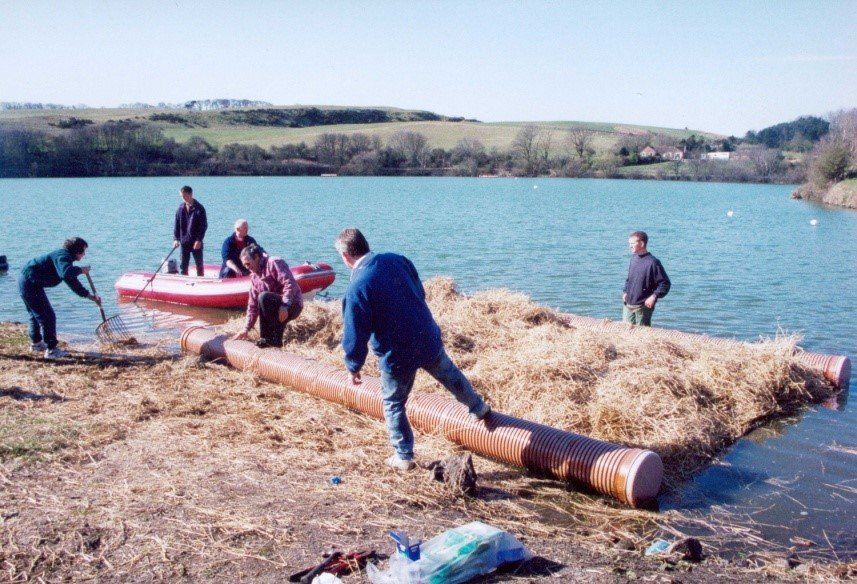1. Pollution of Kinghorn Loch

Algal bloom at the loch - a thing of the past.
Kinghorn Loch was polluted with a highly alkaline liquor that was leaching from Whinnyhall Landfill Site. This occurred from 1950s to 1983, by which time the loch was dead, except for midge larvae and blue-green algal blooms.
After 1983 the loch was effectively cleaned up and now has a healthy ecosystem and excellent water quality.
POLLUTION OF KINGHORN LOCH.
- From 1950s British Alcan Aluminium deposited Red Mud at Whinnyhall, west of Kinghorn Loch. Red Mud is the waste that remains from the treatment of bauxite with caustic soda, which dissolves up the valuable aluminium oxide to leaves the insoluble waste. At Burntisland the caustic liquor was neutralised and dried to give additives for toothpaste and cosmetics.
- The Red Mud was washed to remove most of the caustic and pressed into a thick paste before disposal.
- However, liquor from landfill drained into the loch as a leachate.
- By 1970s, the pH of the loch had risen to a level whereby fish were absent and rooted plant growth failed. Blue-green algal blooms persisted throughout the year and only resistant midge larvae survived. The particular midge larvae was tolerant of the high levels of arsenic in the water.
- After a research programme, the leachate was removed from the loch in 1983 and initial recovery was rapid.
- Dr Ron Edwards of the Forth River Purification Board was responsible for working with British Aluminium in remediating the situation. This project was from 1980 to 1986.
RESEARCHING THE PROBLEM.

1981: foam around the loch and a young Marilyn

-Thick layer of iron rich sediments. Hydrated iron oxide solids from the Red Mud leachate.
-Soaking up (adsorbing) arsenic and phosphate into the sediments
-Local waters are nitrate rich, being Coalfield-derived groundwater, naturally rich in nitrate.
-Phosphorus is the limiting nutrient, because nitrate is high.

1985: Photographing a core taken at the head of the loch. Formed primarily of Red Mud material over natural peat.

In 1983, once the pH of the water dropped the "sludgy" sediment collapsed to a thicker consistency, the water became clear and rare plants, such as Water Hyacinth, arrived.
However, by 1990, algal blooms once again became rife, lasting all year on occasions, and stifling other plants.
Nutrients (nitrate and phosphate) in the water encouraged the blooms.
The picture shows Mediterranean green, algae-rich water and the barley straw rafts built to treat the problem.
COMING TOGETHER TO TREAT THE PROBLEM.
BARLEY STRAW TREATMENT RAFTS.
- Around 1995, Kinghorn Community Council set up a Loch Action Group to tackle the problem, which became the Loch Users Group (KLUG) in 1998.
- The Group investigated possible treatment with barley straw, an untested technique with no scientific theory for how it works.
- It was clear that the straw had to be aerated, so straw had to be well-feathered otherwise it just rots!
- KLUG designed rafts to carry the straw and keep it aerated and built, mainly with donated materials.
- From 2001, six bales were put out, twice a year to effect treatment.
- By 2010, the algal blooms were a thing of the past, except for very short lived, sporadic blooms of no consequence. The treatment has worked very well.
- A maintenance regime, of four bales, put out once a year, is still in place.
- With sunlight able to get to the sediment, rooted plants are now dominant and water quality excellent.
Straw has been donated by Banchory Farm every year for 22 years.


FURTHER RESEARCH PROJECTS.
- The Centre for Ecology and Hydrology (CEH) at Bush in Edinburgh has recently investigated the fate of arsenic in the loch, as arsenic pollution is becoming a problem in Asia with metal refining. The loch provides a rare glimpse of the long-term fate of arsenic pollution in freshwater from anywhere in the world, so is a valuable test ground.
- The level of arsenic in the loch remains at a very low level, well below the Environmental Quality Standard.
- CEH is now undertaking a study of vanadium in the loch as it becomes of interest globally. Vanadium has low toxicity and has been little studied in the past.
- The water quality in the loch is now excellent.

Loch as it is now.
As algal blooms have been controlled and eliminated, rooted plants have more sunlight and have thrived. Rooted plants are now dominant, aerating the water and giving refuge to nesting mallard, coots, and others, feeding the fish and protecting frog and toad tadpoles from the pike.
Otters are often seen at the loch, and the remains of carp are often found on the banks.
The raft in the middle of the picture shows the scale of the loch.
SOURCE OF THE POLLUTION - WHINYHALL LANDFILL SITE.

1990

Whinnyhall Landfill Site - remediated - green and pleasant view.
Newsletters and Booklets
Our publications are online for free download.
View our newsletters archive.
Become a Friend of Craigencalt Trust
Help us manage and maintain the loch and the countryside.
Correspondence address: Craigencalt Cottage, Kinghorn,
KY3 9YG, Scotland, UK
Marilyn. Tel: 07740 999 514